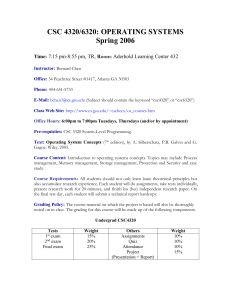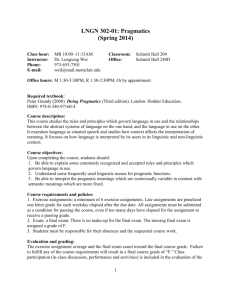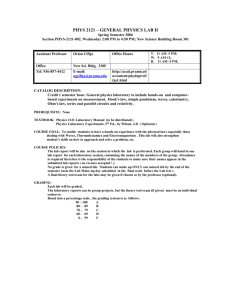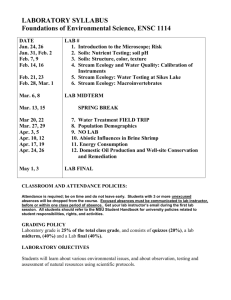Math 225-01, Spring 2012 Introduction to Biostatistics
advertisement
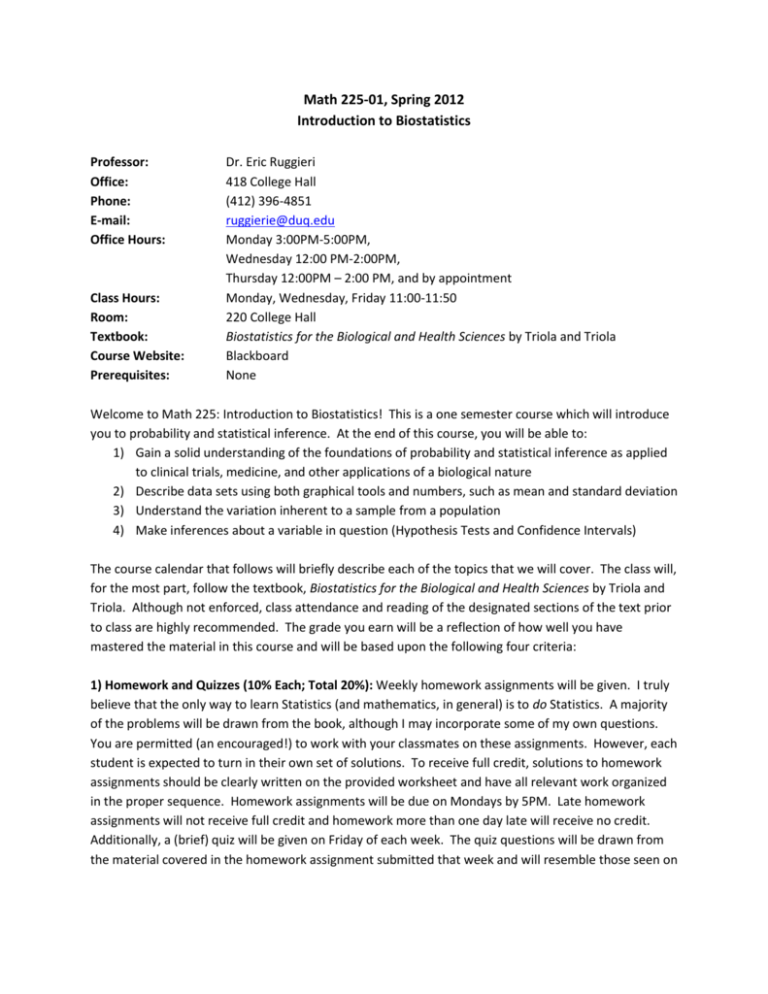
Math 225-01, Spring 2012 Introduction to Biostatistics Professor: Office: Phone: E-mail: Office Hours: Class Hours: Room: Textbook: Course Website: Prerequisites: Dr. Eric Ruggieri 418 College Hall (412) 396-4851 ruggierie@duq.edu Monday 3:00PM-5:00PM, Wednesday 12:00 PM-2:00PM, Thursday 12:00PM – 2:00 PM, and by appointment Monday, Wednesday, Friday 11:00-11:50 220 College Hall Biostatistics for the Biological and Health Sciences by Triola and Triola Blackboard None Welcome to Math 225: Introduction to Biostatistics! This is a one semester course which will introduce you to probability and statistical inference. At the end of this course, you will be able to: 1) Gain a solid understanding of the foundations of probability and statistical inference as applied to clinical trials, medicine, and other applications of a biological nature 2) Describe data sets using both graphical tools and numbers, such as mean and standard deviation 3) Understand the variation inherent to a sample from a population 4) Make inferences about a variable in question (Hypothesis Tests and Confidence Intervals) The course calendar that follows will briefly describe each of the topics that we will cover. The class will, for the most part, follow the textbook, Biostatistics for the Biological and Health Sciences by Triola and Triola. Although not enforced, class attendance and reading of the designated sections of the text prior to class are highly recommended. The grade you earn will be a reflection of how well you have mastered the material in this course and will be based upon the following four criteria: 1) Homework and Quizzes (10% Each; Total 20%): Weekly homework assignments will be given. I truly believe that the only way to learn Statistics (and mathematics, in general) is to do Statistics. A majority of the problems will be drawn from the book, although I may incorporate some of my own questions. You are permitted (an encouraged!) to work with your classmates on these assignments. However, each student is expected to turn in their own set of solutions. To receive full credit, solutions to homework assignments should be clearly written on the provided worksheet and have all relevant work organized in the proper sequence. Homework assignments will be due on Mondays by 5PM. Late homework assignments will not receive full credit and homework more than one day late will receive no credit. Additionally, a (brief) quiz will be given on Friday of each week. The quiz questions will be drawn from the material covered in the homework assignment submitted that week and will resemble those seen on homework assignments. If necessary, quiz make-ups must be complete by the time quizzes are handed back at the start of class the following Monday unless prior arrangements have been made. 2) Group Project (15%): Since the goal of this course is to understand how statistics are used in a biological setting, you will be asked to find a research paper that uses statistics and present the results of this paper to your classmates. The paper you wish to present and a short (1 page) description of the statistical methods used in that paper will be due before you leave for Easter break on Wednesday April 4th (worth 10% of the project grade). The second part of this project is a brief meeting (by Friday April 13th) in order to go over the statistics discussed in your journal article (10%). The final 80% of the project grade will be evenly split between your presentation and a written report. No one is expected to be an expert on the topic that you have selected. Therefore, both the presentation and written report/summary of your research paper should introduce the problem you are investigating, describe the methodology for gathering and analyzing the data, and contain a summary of the results. Try to think critically about any conclusions drawn in the paper. Are they adequately supported? While the focus of many published journal articles is on the underlying biology, your report should be more focused on how the data was gathered and the statistical methods used, as well as an introduction to the biological question being studied. The project presentations will take place on the final 2-3 days of class; the written reports (3-5 pages) will also be due at that time and should mirror your presentation. Late submission of any of the three pieces of this project will not receive full credit. Additional project details and example papers will be forthcoming. 3) Two In-Class Exams (40%): There will be two cumulative in-class tests. The exams will not be exercises in memorization, but will try to be written so that students with a solid understanding of the concepts should have little, if any, trouble. The first exam is tentatively set for Friday February 10th, the second for Wednesday March 28th. 4) Final Exam (25%): The comprehensive final examination is from 8:30 AM to 10:30 AM on Thursday April 26th in accordance with the Duquesne University catalog. Should you ever need help with this course, there are several great options available to you: 1) Ask a classmate for help 2) Stop by my office during office hours or make an appointment to see me 3) Departmental Tutoring – Meet one-on-one with former Statistics students. 4) Meet with the TA for our course. Hours and location forthcoming. Additional Course Policies: Academic Integrity: A student found cheating on an examination or assisting others in the course of an examination will receive an F for the course and will be subject to further sanctions. Copying another student’s assignment is considered cheating and will result in receiving a 0 for that assignment. As previously stated, you are encouraged to work together on homework assignments. However, each student is expected to write out their own solutions. For more information, please see the University’s Academic Integrity Policy, which can be found at: http://www.duq.edu/academicaffairs/_pdf/academic-integrity-policy.pdf Information for Students with Disabilities: Duquesne University is committed to providing all students with equal access to learning. If you think you have a disability requiring accommodations, you must register with the Office of Freshman Development and Special Student Services in 309 Duquesne Union (412-396-6657) in order to receive reasonable accommodations in this course. Once a disability is officially documented at Duquesne by this office, and with your permission, instructors will receive letters outlining the reasonable accommodations they are required to make. Once I have received this letter, you and I should meet to coordinate the way these will be implemented in this course. For more information, go to http://www.duq.edu/special-students/policies.cfm Calculators: A calculator is highly recommended but not required. You do not need to go out and buy a graphing calculator - a basic calculator will be sufficient for our course. Using your cell phone as a calculator is not permitted since phones are meant as communication devices (See Academic Integrity above). Grading: Final grades will be given according to the following percentage cutoffs. These cutoffs, although fairly strict, can be lowered (according to class performance), but not raised, no matter how well the class performs Final Grade Percentage A 93 to 100 A90 to <93 B+ 87 to <90 B 83 to <87 B80 to <83 C+ 77 to <80 C 70 to <77 D 63 to <70 F 0 to <63 Course Calendar (subject to change) Date Section Topic Jan 6 – F No Class! Jan 9 – M 1.1-1.2 Syllabus; Types of Data Jan 11 – W 1.2-1.3 Design of Experiments Jan 13 – F 2.1-2.3 Visualizing Data Jan 16 – M No Class! MLK Day Jan 18 – W 2.1-2.3 Visualizing Data, cont. Jan 20 – F 2.4 Measures of Center Notes HMWK #1 Due Quiz #1 Date Section Jan 23 – M 2.5 Jan 25 – W 2.6 Jan 27 – F 2.7 Jan 30 – M 3.1-3.3 Feb 1 – W 3.3-3.4 Feb 3 – F 3.5 Feb 6 – M 3.6 Feb 8 – W 1.1-3.6 Feb 10 – F 1.1-3.6 Feb 13 – M 4.1-4.2 Feb 15 – W 4.3, 3.8 Feb 17 – F 4.3-4.4 Feb 20 – M 4.5, 5.1-5.2 Feb 22 – W 5.2 Feb 24 – F 5.3 Feb 27 – Mar 2 Mar 5 – M 5.6 Mar 7 – W 5.4 Mar 9 – F 5.4 Mar 12 – M 5.5 Mar 14 – W 6.1-6.2 Mar 16 – F 6.2 Mar 19 – M 6.3 Mar 21 – W 6.4 Mar 23 – F 6.5 Mar 26 – M 4.1-6.5 Mar 28 – W 4.1-6.5 Mar 30 – F 7.1-7.2 Apr 2 – M 7.3 Apr 4 – W 7.4-7.5 Apr 6-9 Apr 10 – T 7.6 Topic Measures of Variation Measures of Relative Standing Exploratory Data Analysis Intro to Probability; Probability Rules Addition and Multiplication Rules Multiplication: Beyond the Basics Risk and Odds Catch Up / Review for Exam #1 Exam #1 – Chapters 1-3 Discrete Probability; Random Variables Binomial Distribution; Counting Binomial Distribution, cont. Poisson, Uniform Distributions The Standard Normal Distribution Applications to the Normal Distribution No Class! Spring Break! Normal Approx. to the Binomial Sampling Distributions Sampling Distributions, cont. Central Limit Theorem Estimating a Population Proportion Estimating a Population Proportion, cont. Estimating a Population Mean, σ known Estimating a Population Mean, σ unknown Estimating a Population Variance Review for Exam #2 Exam #2 – Chapters 4-6 Introduction to Hypothesis Testing Testing a Claim: Proportion Testing a Claim: Mean No Class! Easter Break Testing a Claim: Variance Apr 11 – W Apr 13 – F 8.1-8.2 8.3 Testing a Claim: Two Proportions Testing a Claim: Two Means Apr 16 – M Apr 18 – W Apr 20 – F Apr 23 – M 8.3 8.4 Testing a Claim: Two Means, cont. Matched Pairs Inference Project Presentations Project Presentations Thursday April 26th – Final Exam, 8:30AM – 10:30AM Notes HMWK #2 Due Quiz #2 HMWK #3 Due Quiz #3 HMWK #4 Due HMWK #5 Due Quiz #5 HMWK #6 Due Quiz #6 HMWK #7 Due Quiz #7 HMWK #8 Due Quiz #8 HMWK #9 Optional Project Description Due Monday Schedule HMWK #10 Due Quiz #10 Project Meetings HMWK #11 Due Last Day of Class Project Written Report Due
